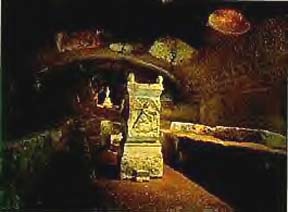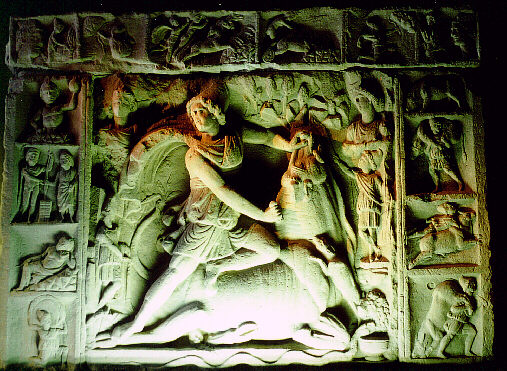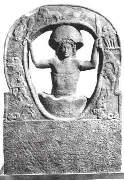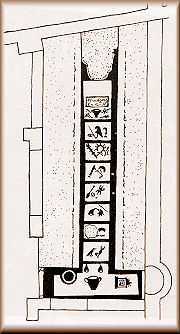
Fig. 6. The grades on a mosaic from a mithraeum in Ostia.
There are quite a few inscriptions in mithraea identifying members by name and grade. The most common grade mentioned was Pater. This is to be expected, since Paters would have been in charge of mithraea. A large percentage of the rest are by Leos. From this we can conclude that there was something important about that grade. Did it mark an important stage in an initiateís progress? Was it the highest grade most members reached? It is possible for both of these to be true, and, as we shall see later, I think that likely.
This has been a quick summary of the data. You can see a lot of the artifacts through the links on this page. Now I'd like to turn to possible explanations that have been proposed for the data.
Around the turn between the 19th and 20th centuries, Franz Cumont published a number of books on Mithraism. One, The Mysteries of Mithra, is still in print. Cumont believed that Mithraism must be interpreted in light of Zoroastrianism, the religion of Persia. This is a fairly obvious approach. Mithras is the name of a Zoroastrian "god," Mithras and his torchbearers are dressed like Persians, and the Persian words nama "hail," and nabarzes, probably "unconquered," appear in some Mithraic inscriptions.
Cumont interpreted the tauroctony as an act of creation. From the bullís death life entered the world. This idea is supported by the fact that in some of the tauroctonies there is grain springing from the bullís wound or from his tail. The dog and the snake Cumont explained as good and evil fighting for the sacred blood, while the scorpion was one of the forces of evil trying to attack the divine bull. The lion-headed deity was Zurvan, Infinite Time, a divine figure in a heretical form of Zoroastrianism.
With his works, Cumont established the field of Mithraic studies. He established it with such authority that his work remained essentially unchallenged for seventy years. Then doubts began to appear. The problem hadnít really been faced that the defining characteristics of Mithraism - the tauroctony, the secrecy and initiations, the masculine exclusivity - have no parallels from Persia. The principle of explaining Mithraism as directly descended from Zoroastrianism have therefore been abandoned. (David Ulansey, pp. 10 - 12, gives a summary of the critique, and gives the references for those wanting to study the question in greater depth.)
Reading through Cumont for the purpose of this essay, I was appalled at some of the things he said, and I even wonder why it took so long to see problems. The chapter entitled "The Mithraic Liturgy, Clergy, and Devotees" is particularly egregious. In it he attempts to give a picture of what rituals in a mithraeum would have been like. Unfortunately, most of it comes from his own imagination, rather than from the evidence. He gives a very detailed description of an initiation ritual (pp. 163 - 164), after earlier in the chapter telling us that we donít know much about Mithraic ritual. On page 166 we learn that "A solemn moment in the service, - one very probably marked by the sounding of a bell, - was that in which the image of the tauroctonous Mithra, hitherto kept veiled, was uncovered before the eyes of the initiates." Where the veil, or the ritual uncovering, has come from I donít know. Cumont presents his speculative rituals as fact; the "very probably" is as hesitant as he gets. In short, I think that the critics of Cumont let him off easy.
No clear alternative to Cumont has emerged. The most promising direction of investigation has come through a recognition of the importance of astrology in Mithraism, especially in the tauroctony. The major elements of that image can be identified with constellations - Taurus, Scorpio, Canis Major, Hydra, and Gemini. Some tauroctonies include a lion (Leo) and a large cup (Crater). Mithras himself would be Perseus. This suggestion was actually made in 1869 by K. B. Stark (Ulansey, pp. 15 - 16), but Cumontís authority as an expert in both Mithraism and astrology led to Starkís theory being rejected.
Starkís theory is, however, very reasonable. The question then becomes what the significance of this star map tauroctony is. Why would Mithraists have put a map of part of the sky as the most important part of their temples?
The most comprehensive attempt to answer this question is that of David Ulansey. He puts forth the idea that the central secret of Mithraism was the precession of the equinoxes, and that Mithras killing the bull is his bringing about the change of the spring equinox from occurring in Taurus to occurring in Aries. The lion-headed god he explains as a god of time whom Mithras, by being the one who turns the axis of the cosmos, overcame.
The significance of the precession of the equinoxes comes from a belief common in the Graeco-Roman world, that after death souls go up through the planetary spheres to reach the celestial regions. It was the purpose of some of the mystery religions and philosophies to teach initiates how to make this trip safely. Knowing the role of the equinoxes would be crucial to ascending properly, since they indicated the layout of the cosmos.
I see a number of problems with Ulanseyís theories. First, the precession of the equinoxes wasnít a secret at the time of Mithraism. It would have been odd for a mystery religion to have developed to bring its members through a series of initiations to learn something that wasnít a secret. Second, he does not adequately deal with the lion-headed god; under Ulanseyís scheme he is reduced to a fairly insignificant role. I find it hard to imagine that as complex an image as the leontocephalous was devised to play such a role. There are two further facts that argue against this: Mithras is never shown overcoming the leontocephalous, and there are the inscriptions dedicated to him. Why would Mithraists carve inscriptions in honor of a being overcome by Mithras? I do think that Ulansey is partly right here, but that he has missed the significance both of the leontocephalous and of the overcoming. That will become clear later.
There are two further objections to Ulanseyís theory that I think doom it. First, he postulates that the meaning of the tauroctony is that the equinox has changed from Taurus. Nowhere in the mithraea, however, do find an indication of what the equinox has changed to; other than in the ring of the zodiac Aries is absent. Even more deadly is that in Ulanseyís conception Mithrasí sacrifice of the bull is not a salvific act, but a damning one. Before the precession, things had worked out pretty well; it is only the change that requires us now to know the secret of how to be saved. But on the walls of the Santa Prisca mithraeum we find painted a line that might read, "us too you have saved by blood eternally shed." The reading is not certain, and only "by blood shed" is sure (Beck, p. 2029), but if indeed it does say this, we are drawn to the conclusion that the bull-slaying is one of salvation. Roger Beck, while noting the uncertainty of the reading of the Santa Prisca line, says later in his article, "even if we did not have the evidence of the Santa Prisca text ... [that the bull-slaying is an act of salvation] could surely be inferred from the mere fact of tauroctonyís absolute centrality. ... In the context of the religion of the times it is hard to imagine where the relevance might lie if not in salvation." That seems a more than reasonable position to me; I am unaware of a religion of salvation whose primary icon is a symbol of that from which salvation is to be gained.
That the tauroctony is a star map is an important observation. Ulanseyís explanation of it doesnít hold up, however.
I would like to try a different approach. The obvious course of explaining Mithraism has been through the ubiquitous tauroctony. The concentration on doing so has neglected, however, an important element of the religion. Mithraism was a religion of salvation. Mithras provided this salvation through his sacrifice of the bull. But how was this salvation to be attained by human beings? That is the question that has been ignored.
To express the problem differently, the tauroctony has often been compared, as a result of its omnipresence and evident importance, to the Roman Catholic crucifix. Analogies can be pushed too far, but this one suggests something more than what those who made it considered. The crucifixion is not, in fact, the central mystery of Christianity, the Resurrection is. Yet the latter is rarely represented in churches. This should make us hesitate to see the meaning of the tauroctony as the final answer to Mithraism.
If Mithraism is a religion of salvation, it must provide a way to achieve salvation. It isnít much of a risk to say that this was accomplished through the series of initiations represented by the grades. I think then that just like an ancient Roman we can approach the secret of Mithraism by going through the grades of initiation.
The first grade is that of the Raven. We have seen that in the images of the meal between Mithras and the Sun they are sometimes served by men with the heads of ravens. Since it is likely that the meal in the mithraeum was intended to be a copy of that one, it is also likely that the initiates in the grade of Raven served at the ritual meal. Whether they wore ravenís masks, or whether the representations of raven-headed men was meant as a piece of mythical symbolism, is not particularly important. That the Ravens would have served the meal is further indicated by logic; someone had to serve it, the Mithraists would certainly not have allowed non-initiates to be present at so central a meal, and as the low men on the totem pole the Ravens were the obvious choice.
There is a transcendent value to service in any religion, though. I think that in the case of the Raven there is more going on than being a waiter. We have to ask the question of what a raven is doing as the beginning grade of initiation in the first place. What was the significance of ravens in the Roman world? R. L. Gordon gives an interesting collection of the meanings of ravens in the classical world (1980, pp. 26 - 32). He chooses to emphasize that ravens could be seen as intermediaries between the world of the gods and the world of men. The raven in the tauroctony, who comes from the sun, may be filling this role. With the position of the grade of Raven on the border between the life of the initiate and that of the rest of the world that is certainly one of the possible meanings. I would like, however, to emphasize another element of what ravens were to the Graeco-Romans, one that Gordon himself points out when he writes that the raven "shared with men a rational faculty" (1980, p. 26). Seen this way, the grade of Raven, involving a submission into service, specifically involves submission of oneís rational faculties.
The second grade has an interesting name: nymphus. What is interesting about it is that there is in fact no such word in Latin. "Nympha" is a bride. -us is a masculine ending, so by using it to replace the feminine ending -a we obtain a self-contradictory word meaning "male bride."
I think that using nuns as an analogy might help us understand the meaning of this grade. Nuns are "the brides of Christ," they are married to him. Mithraists were all men, and couldnít really be married to Mithras. They could, however, be married to him in a ritual sense.
What would that sense mean? In Roman society, wives were subservient to their husbands. To be a wife was to be submissive. A Nymphus, then, was submissive to Mithras in the same way that a wife was to her husband.
A particular kind of submission was emphasized here by the grade of Nymphus being associated with the planet, and thus the goddess, Venus, the goddess of romance and sexuality. By becoming a Nymphus, then, the initiate put his emotions and sexuality into the control of Mithras; he gave them up.
The next level of initiation is that of Soldier. Tertullian tells us about the initiation ritual of this grade; the initiate is presented with a crown on a sword, and he has to spurn it, saying, "My crown is Mithras!" (Clauss, pp. 134 - 135). We can see in this once more an aspect of submission; the initiate recognizes in Mithras the glory he himself might wish to attain. As a soldier, however, it is specifically his physical force that he is giving up.
We now turn to the crucial grade of Leo, the Lion. This grade is associated with fire; we find, for instance, painted on the wall of the Santa Prisca mithraeum, the lines, "Receive the incense burners, Father, receive the Lions." Even more clearly, Tertullian tells us that that the Leo is "of a dry and fiery nature," and Porphyry informs us that he is "an initiate of fire." (Both of these quotations may be found in Clauss, p. 134.) Porphyry gives us an interesting detail of Mithraic initiation ritual. He says that since the Lions are fiery, in their initiations they canít be purified with water. Instead honey is used, since that has a fiery nature. (I have personally never been able to understand how one washes oneself with honey; the result would simply be stickiness.)
With the grade of Lion, then, we reach fire. We have seen the initiate submit his mind, emotions/sexuality, and physical force to Mithras. What is the function of fire?
At this moment of high drama it is time for a digression.
The Mediterranean at the time we are looking at seethed with religious and magical ideas and practices, mixing together to form a variety of syncretistic religions. Weíve already seen this with Mithraism: astrology, Zoroastrianism, mystery traditions, Roman religion, and who knows what else. To this mix I am suggesting we add Gnosticism.
Gnosticism gets its name from "gnosis," a secret knowledge. Such knowledge was to be gained through initiation. Although we are most used to associating Gnosticism with Christianity, Gnostic traditions were found as elements of non-Christian religions.
Like Mithraism, Gnosticism was a religion (or philosophy) or salvation. The Gnostics saw the material as evil (or at least inferior), created by a lesser God referred to as the Demiurge. Imprisoned within the material was a divine spark, which came from the true God who dwelt in the spiritual world beyond that created by the Demiurge. The goal of Gnosticism was to purify oneself from the material in order to free oneís spirit. One was to leap over the evil (or deluded) Demiurge into heaven.
As creator of the material, the Demiurge was a god of time and space, opposed to that which is beyond them. Remember also that the Demiurge was an evil god.
I must make one more slight digression, and then I will tie both back into my presentation of Mithraism.
The Graeco-Roman religious or philosophical system of Stoicism contained a doctrine concerning the end of the world. The entire cosmos was to be destroyed in a great conflagration. Time and space were to be burned up and then reconstituted into a new universe.
If such a belief, that of the destruction of the cosmos by fire, were to have been part of Mithraic doctrine, there is no doubt as to where it would belong in the course of initiation; it would be at level of the Lion. That is, after all, the grade of fire.
But fire was not just connected with the human lion. It was connected with the divine lion, the leontocephalous. We see, for instance, an illustration of him holding torches and with fire coming from his mouth to light an altar. Some of the statues of him have holes through the back of his head to his open mouth, through which fire might presumably been blown.
 
Fig. 7 Rome Fig. 8
Now if Mithraism had partaken of the Gnostic view of the cosmos, what would have been the identity of the Demiurge? If one were to devise a Gnostic religion based in part on Zoroastrianism, the obvious choice would be Ahriman, the evil spirit/god of that religion. It is exactly Ahriman whom we see in the mithraea, under the name "Ariomanus," the lion-headed god. This deity is certainly one of time, and I suggest that he was one of space as well. This is illustrated perfectly in the tauroctony from Barberini:
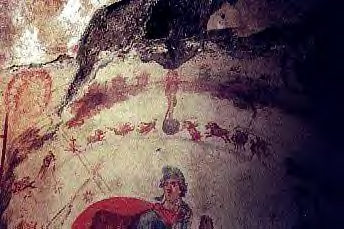
Fig. 9 Barberini Mithraeum, Rome (CIMRM 390)
Here we see the leontocephalous at the summit of the world cave, serving as both a barrier to those who would ascend out of space and time, and a keystone which, if removed, would destroy them, presumbably into the great conflagration.
If we combine all of this, we get an image of the leontocephalous as standing at a crucial juncture between the material world and the divine one. He is a lion, and he is fire. He belongs at the grade of Lion. Based on the large number of dedications by Lions, the grade was clearly important. I am suggesting that it was at the center of the ladder in more ways than one.
In our trip through the grades we have seen the initiate submit more and more of his material, that is, non-divine, life to Mithras. He now arrives at a horrifying point. He must face the Demiurge, Ariomanus who has stared down at him from statues and murals. Ariomanus is the monster who must be passed to reach the realm of the divine. How does the initiate make this crossing? Through fire.
Here, then, is one of the mysteries of Mithraism. The Demiurge, the creator of the material and imprisoner of the spiritual, is himself the means by which the soul of the initiate can escape the material. Purified partially by submitting the elements of his personal life to Mithras, the initiate must now be purified completely. He must, like the Stoic universe, be completely burned. And, through this burning, he passes beyond the limitations of the cosmic cave and the zodiac and enters into the divine realm. Ariomanus, who had been seen as a terrible demon, turns out to be a necessary servant of the divine will. Whether he knew himself to be so is something that canít be determined, but he was nonetheless.
That the interpretation of the grade of Leo as being one of consumption finds confirmation in the Santa Prisca mithraeum, where the full text of what was quoted earlier reads, "Receive the incense-burners, Father, receive the Lions, Holy One, through whom we offer incense, through whom we are ourselves consumed." The Lion is consumed, and, through his ritual role, can consume others, bringing part of salvation to those who have not yet reached his grade.
With this view in mind, we need to look at Mithras Petragenetrix again. It is certainly a representation of the birth of Mithras. But which one? In many he is shown as an infant, but in a number he is shown as an adult. Even in those where he is a child he holds his dagger, and often a torch. The dagger is of course that with which the bull is slain. The torch has, to my knowledge, gone unexplained. It's been compared to that held by Cautes and Cautapotes, but why should Mithras be holding one?
My suggestion here is that we consider the possibility common in mystery religions that a symbol might have more than one meaning, with a deeper mystery revealed to higher initiates. Mithras Petragenetrix is indeed Mithras born as a child. But it is also Mithras reborn through the burning down of the cosmos. The dagger he carries is not just the one with which he will kill the bull, but the one with which he had killed the bull, and the rock is the world cave. Look again at the first image of the rock birth I gave above, and you will see that Mithras isn't being born into the zodiacal ring, but out of it. Further, in the second he is breaking open the cosmic egg (Ulansey, p. 122). The torch is thus that of the leontocephalous; the cosmos has been burned down, and Mithras/the initiate has escaped into the divine realm.
This suggestion is close to confirmed by three more images of Mithras petragenetrix. The first includes a hole, like the one in the leontocephalous shown earlier:
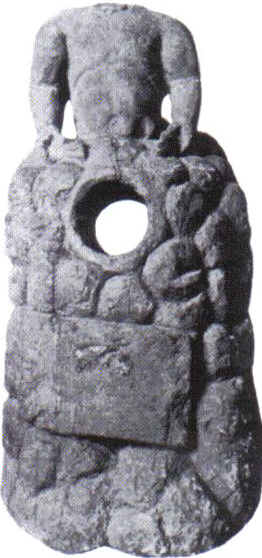
Fig. 10
This time the hole from which flame would have come is in the rock; the world cave is aflame, and the fire is below him -- he has ascended above/out of it. The point is made even more strongly by another image:
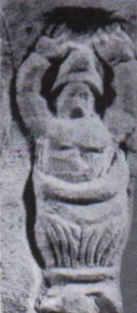
Fig. 11
It lacks artistry, but the message is clear; again the cosmos is on fire and the new-born Mithras is rising out of it.
Finally, we have this tauroctony from Stockstadt:
 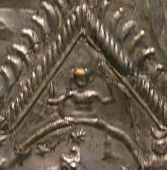
Fig. 12 Fig. 13
The ritual has been placed inside a temple, but look at what is at the top of the arch -- a petragenetrix. The symbolism could hardly be more obvious. Just as in the other tauroctony the leontocephalous was plugging the hole out of the world cave, so here Mithras has made his way out, reborn from the rock of the cosmos, into the celestial realm.
The initiate has been reborn along with Mithras, and now acquires the grade named after Mithras, the Persian. He would next continue on to that of Heliodromus. If we accept Gordonís suggestion that rather than the usual ďCourier (or Runner) of the Sun,Ē it should more correctly be seen as ďOne Who Proceeds Like the SunĒ (1994, p. 111),that grade becomes Mithras exalted to the level of, or even higher than, that of the sun, which is exactly what we see on many of the images surrounding the tauroctonies. Mithras has been given the solar crown, and now is even greater than the sun, because he's burned down his own cosmos.
With this framework in which to describe Mithraism, we can now return to the tauroctony. If the method of salvation I have suggested, the submission of the material followed by its destruction by the fire of the leontocephalous, is correct, and if it is the slaying of the bull that saved Mithraists, in what way does the slaying contribute to the process of submission and destruction? I would say that it doesnít. Its job is more important.
It is here that we can resurrect the suggestion by Cumont that the killing of the bull is a creative act. This is supported by the grain sprouting from the bullís tail, and fits in well with general Indo-European views on sacrifice as creative (see Lincoln, 1986). The objection to this has always been that in Zoroastrianism there is no sacrifice of a bull at the beginning of time, and that the closest we find is Ahriman killing one. This is indeed true regarding the creation of the world.
However, Zoroastrianism has it that at the end of time all evil will be burned away with molten metal, after which Soshyant, the Zoroastrian ďsavior,Ē will sacrifice a bull, and form from its fat and other materials a drink of immortality. The good will drink from it and live forever (described in the Greater Bundahisn 34). We see here a doctrine that the sacrifice of a bull (not simply the killing, as was done by Ahriman) is to be the means of final salvation when the world is recreated after the old one has been done away with through fire. It is exactly this sort of destruction by fire, individualized for the initiate, that I am suggesting for Mithraism. If this is true, then it is in keeping with Zoroastrian belief that such a destruction would be followed by an immortality-granting sacrifice of a bull (albeit not by Mithra). And this is again what I am suggesting here.
My solution to the bull-slaying mystery, then, is that it is a reinterpretation of a Zoroastrian myth, as filtered through the sort of ideas mixing around classical society in the first century - a little Stoicism here, some Gnosticism there, a bit of astrology for spice. Through the agency of the leontocephalous the world cave is destroyed by fire. Mithras sacrifices the bull, bringing into being a new world, into which he bursts, born from the cave (in at least one case, the world egg). He becomes in that world the preeminent ruler, equal to the sun in ours.
It is pretty common in mystery religions for there to be symbols which have both exoteric and esoteric meanings, and I think that that was the case for Mithraism. Not only the basic level initiate, but the sculptors, painters, and architects who created the mithraea and their furnishings, would have wanted to know the meaning of the imagery. In fact, there is even jewelry with the tauroctony on it; the image itself clearly was no secret.
It is here that the obvious meanings would have been presented: Mithras was born from a rock, he brought life into being by killing the bull, and was therefore raised to equality with the Sun. Initiates are even able to feast with the sun like Mithras, the explanation could have gone. The leontocephalous might have been a bit trickier, but perhaps he was just an underworld deity in the exoteric system. It would only have been when the initiate was ready that the true meaning of the images would have been revealed.
The significance of the star map nature of the tauroctony remains unsolved in this theory. However, it would not have been the reason for the bull-slaying doctrine itself to have come into existence. Both snake and dog play important roles in Zoroastrianism, and their presence, added to the fascination of the creators of Mithraism with astrology, would have been sufficient to suggest the addition of other ďconstellationsĒ to the image. The symbolic identification would have had doctrinal implications, of course, and that should be investigated, but I think it misguided to see the astrological meaning as the primary one.
The procession of the initiate through the grades represents a coherent system, then, and that progress makes sense when Mithraism is seen as a blend of Roman with Gnostic, Stoic, and Zoroastrian elements. It is likely, however, that the final secrets of Mithraism died with the last initiate. For now, the fellow in the cap still looks out at us, performing his enigmatically salvific act.
References:
Most of the information in this essay can be considered to be common knowledge in the field of Mithraic studies, and I therefore refer anyone interested in following up on it to the books and articles in the Mithraism reading list elsewhere on this site. The following are books specifically referred to, and ones not on that list.
Beck, Roger. Mithraism Since Franz Cumont. Aufstieg und Niedergang der RŲmischen Welt II.17.4 (1984), pp. 2002-2115.
Cumont, Franz. The Mysteries of Mithra. tr. Thomas J. McCormack. New York: Dover Publications, 1956 (1903).
Gordon, R. L. Gordon. Reality, Evocation and Boundary in the Mysteries of Mithras. Journal of Mithraic Studies III (1980), pp. 19 - 99.
--Mystery, Metaphor and Doctrine in the Mysteries of Mithras. Studies in Mithraism. ed. John R. Hinnells. Rome: LíErma di Bretschneider, 1994.
Lincoln, Bruce. Myth, Cosmos and Society: Indo-European Themes of Creation and Destruction. Cambridge, MA: Harvard University Press, 1986.
Pagels, Elaine. The Gnostic Gospels. New York: Random House, 1979.
Sandblach, F. H. The Stoics (2nd ed.). Indianapolis: Hackett Publishing Company, 1989.
Schwartz, Martin. Cautes and Cautopates, the Mithraic Torchbearers. Mithraic Studies, Vol. II. ed. John R. Hinnells. Manchester, UK: Manchester University Press, 1975.
Ulansey, David. The Origins of the Mithraic Mysteries: Cosmology and Salvation in the Ancient World. New York: Oxford University Press, 1989.
Photo sources:
Figure 4
Figure 5
Figure 7
Figures 12 and 13
|

 Main Page
Main Page  Proto Indo-European (PIE) Religion
Proto Indo-European (PIE) Religion  Wicca
Wicca  Mithraism
Mithraism  Ritual
Ritual  Tuadem
Tuadem 
 Back to the Beginnings
Back to the Beginnings  Nuit
Nuit  Dedicant's Program
Dedicant's Program  Prayers
Prayers  Suggested Reading
Suggested Reading  Suggested Links
Suggested Links 
 Paganism
Paganism  About Me
About Me  Publications
Publications  My Calendar
My Calendar  American Paganism
American Paganism  And The Rest
And The Rest 
 Contact Me
Contact Me 



